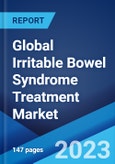The global irritable bowel syndrome treatment market size reached US$ 2.5 Billion in 2022. Looking forward, the market is expected to reach US$ 4.2 Billion by 2028, exhibiting a growth rate (CAGR) of 9.03% during 2022-2028.
Irritable bowel syndrome (IBS) refers to a chronic medical condition that affects the large intestine. It is usually caused by severe infection, stressful lifestyle, changes in gut microbes, muscle contractions in the intestine, and abnormalities in the nervous system. It can be characterized by gas, diarrhea, cramping, bloating, constipation, weight loss, vomiting, abdominal pain, and difficulty in swallowing. Several medications are currently available to relieve mild symptoms of IBS, including rifaximin, loperamide, laxatives, antispasmodics, fiber supplements, and coated peppermint oil capsules. Doctors also recommend probiotics and mental health therapies, such as cognitive behavioral-therapy (CBT), gut-directed hypnotherapy, and relaxation training, to treat certain patients.
Irritable bowel syndrome (IBS) refers to a chronic medical condition that affects the large intestine. It is usually caused by severe infection, stressful lifestyle, changes in gut microbes, muscle contractions in the intestine, and abnormalities in the nervous system. It can be characterized by gas, diarrhea, cramping, bloating, constipation, weight loss, vomiting, abdominal pain, and difficulty in swallowing. Several medications are currently available to relieve mild symptoms of IBS, including rifaximin, loperamide, laxatives, antispasmodics, fiber supplements, and coated peppermint oil capsules. Doctors also recommend probiotics and mental health therapies, such as cognitive behavioral-therapy (CBT), gut-directed hypnotherapy, and relaxation training, to treat certain patients.
Irritable Bowel Syndrome Treatment Market Trends
Several factors increase the risk of IBS diseases, including food intolerances or sensitivities, bacterial infections in the digestive tract, small intestinal bacterial overgrowth, and mental disorders like anxiety, depression, and somatic symptom. This, along with improving diagnostic modalities and easy access to healthcare services, represents one of the key factors bolstering the growth of the market. Furthermore, IBS is one of the most common functional gastrointestinal disorders among the elderly. In confluence with this, the rising geriatric population across the globe is influencing the market positively. Besides this, several clinical trials, such as fecal microbiota transplantation (FMT), are being conducted to improve the treatment of IBS, which is contributing to market growth. In addition to this, as part of the Sustainable Development Goals (SDGs), governing agencies of various countries have pledged to substantially increase spending on research and development (R&D) projects and the number of researchers by 2030. This, in turn, is projected to expand the number of potential treatment options for IBS in the future.Key Market Segmentation
This research provides an analysis of the key trends in each sub-segment of the global irritable bowel syndrome treatment market report, along with forecasts at the global, regional and country level from 2023-2028. The report has categorized the market based on type, product and distribution channel.Breakup by Type:
- IBS with Diarrhea (IBS-D)
- IBS with Constipation (IBS-C)
- Mixed IBS
Breakup by Product:
- Rifaximin
- Eluxadoline
- Lubiprostone
- Linaclotide
Breakup by Distribution Channel:
- Hospitals Pharmacies
- Drug Stores and Retail Pharmacies
- Online Stores
Breakup by Region:
- North America
- United States
- Canada
- Asia-Pacific
- China
- Japan
- India
- South Korea
- Australia
- Indonesia
- Europe
- Germany
- France
- United Kingdom
- Italy
- Spain
- Russia
- Latin America
- Brazil
- Mexico
- Middle East and Africa
Competitive Landscape
The competitive landscape of the industry has also been examined along with the profiles of the key players being Abbott Laboratories, Allergan plc (AbbVie Inc.), Ardelyx Inc., Astellas Pharma Inc., AstraZeneca plc, Bausch Health Companies Inc., GlaxoSmithKline Plc, Novartis AG, Sebela Pharmaceuticals Inc., Synthetic Biologics Inc. and Takeda Pharmaceutical Company Limited.Key Questions Answered in This Report:
- How has the global irritable bowel syndrome treatment market performed so far and how will it perform in the coming years?
- What has been the impact of COVID-19 on the global irritable bowel syndrome treatment market?
- What are the key regional markets?
- What is the breakup of the market based on the type?
- What is the breakup of the market based on the product?
- What is the breakup of the market based on the distribution channel?
- What are the various stages in the value chain of the industry?
- What are the key driving factors and challenges in the industry?
- What is the structure of the global irritable bowel syndrome treatment market and who are the key players?
- What is the degree of competition in the industry?
Table of Contents
1 Preface3 Executive Summary11 Value Chain Analysis13 Price Analysis
2 Scope and Methodology
4 Introduction
5 Global Irritable Bowel Syndrome Treatment Market
6 Market Breakup by Type
7 Market Breakup by Product
8 Market Breakup by Distribution Channel
9 Market Breakup by Region
10 SWOT Analysis
12 Porters Five Forces Analysis
14 Competitive Landscape
Companies Mentioned
- Abbott Laboratories
- Allergan plc (AbbVie Inc.)
- Ardelyx Inc.
- Astellas Pharma Inc.
- AstraZeneca plc
- Bausch Health Companies Inc.
- GlaxoSmithKline Plc
- Novartis AG
- Sebela Pharmaceuticals Inc.
- Synthetic Biologics Inc.
- Takeda Pharmaceutical Company Limited
Methodology

LOADING...
Table Information
| Report Attribute | Details |
|---|---|
| No. of Pages | 147 |
| Published | November 2023 |
| Forecast Period | 2022 - 2028 |
| Estimated Market Value ( USD | $ 2.5 Billion |
| Forecasted Market Value ( USD | $ 4.2 Billion |
| Compound Annual Growth Rate | 9.0% |
| Regions Covered | Global |
| No. of Companies Mentioned | 11 |









